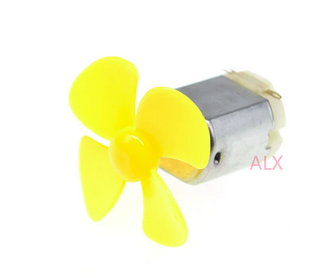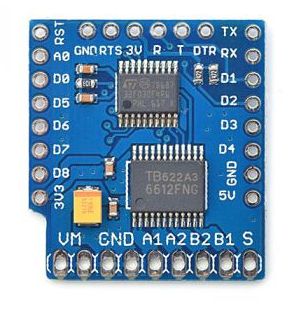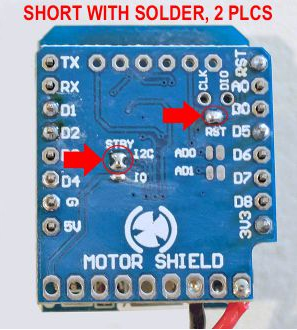Motors
Introduction
We have 3 different types of motors in out kit:- DC motor: Used for continuous movement in either forward or backward direction and at different speeds
- Servo motor: Allows to move to a precise angle. Used e.g. for steering the direction of a robot car, RC controlled model air planes or ships. Allowed angles are usually 0..180 degrees
- Stepping motors: Move in steps and therefore allow to move forward or backward to a precise position of any distance.
The DC motor
The DC motor we use need ~ 350 mA of power and can therefore not be run when the ESP32 power is coming from the USB connector, delivering a maximum ~200mA. We will need an external power supply! The motor is controlled by a motor control shield:
The motor is controlled by a motor control shield:
| Motor Control Shield Front view |
Motor Controller Shield Back side |
 |
 |
- tie the reset pin to the reset signal of the system
- to allow access to motor standby through an I2C command
- A Motor instance must be created with the parameters
- index: 0 or 1 which corresponds to either motor 1 or motor 1 (2 DC motors can be controlled be the shield)
- ic2: an I2C object, which must be created before (we did this in the exercise on the SHT30)
- frequency(freq): if freq == None this method returns the PWM frequency used to control motor speed otherwise its sets the frequency
- speed(motor_speed): if motor_speed == None: returns the current speed,otherwise it sets the speed.
motor_speed values can be 1..10000 to move clockwise or -1..-10000 to move counterclockwise.
I found that for values below 1500 the current is too low to make the motor move - brake: stop the motor
- sleep: put the motor into standby mode to save power
Comments
| I | Attachment | History | Action | Size | Date | Who | Comment |
|---|---|---|---|---|---|---|---|
| |
dcMotorProp.png | r1 | manage | 51.4 K | 2020-06-25 - 08:42 | UliRaich | |
| |
motorShieldBack.png | r1 | manage | 192.2 K | 2020-06-25 - 08:43 | UliRaich | |
| |
motorShieldFront.png | r1 | manage | 170.7 K | 2020-06-25 - 08:43 | UliRaich |
Ideas, requests, problems regarding TWiki? Send feedback



